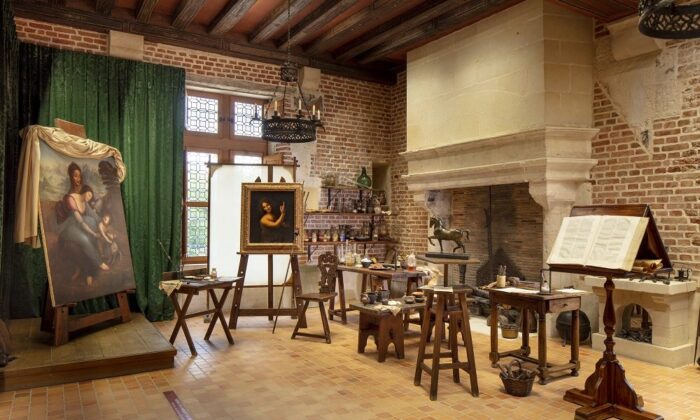
Clos Lucé is located in the picturesque town of Amboise, France, a stone’s throw away from the majestic Loire River. The place has seen more than five centuries of history, bearing a unique, remarkable tale. A tale of a revered genius, the incomparable Leonardo da Vinci, who spent the twilight years of his life here, crafting, contemplating, and creating.
As the dawn breaks over the small town of Amboise, the distinctive pink brick façade of Clos Lucé bathes in the early morning light. This manor house, nestled amongst the greenery, exudes an almost ethereal charm. It whispers stories of its illustrious resident, Leonardo da Vinci, who, far from his native Italy, found a home here during the last three years of his life.
Booking a Loire Valley Tour allows you to see that Clos Lucé was more than just a residence for the acclaimed Renaissance man. It was his sanctuary, a place where he sought and found solace. Living here, Da Vinci, the polymath, had the freedom to unleash his creativity, his ideas bouncing off the manor’s old stone walls, his artistry blossoming within its confines.
A Historical Overview
The roots of Clos Lucé trace back to the 15th century when it was built as a summer house for the nobles of Amboise. Its subsequent ownership by the French monarchy turned it into a favored abode for illustrious visitors, a role it would continue to play throughout the Renaissance. Despite the manifold transformations over centuries, Clos Lucé still preserves its medieval aesthetic, a testament to its enduring legacy.
Peering into its history, we find that Clos Lucé’s claim to fame goes beyond being Leonardo da Vinci’s final residence. King Francis I of France purchased it and, cherishing its calming aura, turned it into his personal retreat. It was Francis I who later invited Leonardo da Vinci to France, offering him this manor house to live and work in.
Leonardo’s Journey to Amboise

Around the year 1516, a nearly 64-year-old Leonardo da Vinci accepted Francis I’s gracious invitation. Leaving behind his native Italy, he traveled across the Alps, bringing along three of his most esteemed artworks, including the world-renowned Mona Lisa. The journey to his new home in Amboise signaled a new chapter in Leonardo’s life, marking an intimate connection between the maestro and Clos Lucé.
Nestled within the French court, Leonardo was warmly received by the king, who held him in high esteem. With the respect and liberty offered by Francis I, Leonardo found himself immersed in a stimulating environment at Clos Lucé, one that would nurture his talents and allow his creative genius to flourish in ways unforeseen.
Leonardo’s Final Years
While at Clos Lucé, Leonardo lived a life of relative seclusion, immersed in his artistic pursuits and scientific studies. The tranquility of this setting, coupled with his close bond with the king, allowed him to explore the depths of his imagination freely. As days turned into years, the manor bore silent witness to Leonardo’s creations, standing tall as a quiet collaborator in his artistic journey.
The artist’s final years were laden with extraordinary achievements. His thoughts, immortalized in thousands of pages of notebooks, reveal the range of his investigations – from designs of flying machines and military fortifications to studies in anatomy and botany. This was a period of intense intellectual activity for Leonardo, a time that underscored his ceaseless pursuit of knowledge.
Leonardo’s Artistic Legacy

Few can deny the indelible impact Leonardo da Vinci had on the world of art. As one explores Clos Lucé, his artistic legacy resonates strongly within its walls. Here, he gave life to many of his drawings, sketches, and plans, leaving behind a trail of his genius that continues to inspire and enthrall.
Among the many creations that came to life at Clos Lucé, the influence of local landscapes on Leonardo’s artwork is evident. The verdant scenery of the Loire Valley served as inspiration for many of his drawings. Even today, echoes of these landscapes can be identified in his artworks, a vivid testament to the influence of his surroundings.
Scientific Innovations and Inventions
Leonardo’s fascination with science and engineering was insatiable. His countless designs of machines – from rudimentary helicopters and tanks to hydraulic pumps – all point to his forward-thinking mindset. Clos Lucé, with its expansive gardens, provided him with the space he needed to experiment with these designs, thus becoming the birthplace of many of his remarkable inventions.
His contributions to the field of anatomy were significant as well. Leonardo’s meticulous dissections and the resulting anatomical drawings made at Clos Lucé have helped advance our understanding of the human body. His keen observations and detailed illustrations underscore his commitment to merging art with scientific inquiry.
The Influence on Leonardo’s Work
There’s no denying the influence of Clos Lucé on Leonardo’s work. The serene environment of the manor, combined with the intellectual stimulation he received from the French court, undoubtedly played a pivotal role in fostering his creativity. Here, he had the freedom to express his ideas, experiment with his inventions, and take his art to unparalleled heights.
And yet, the influence was not one-sided. Leonardo, too, left an indelible mark on Clos Lucé. His time in the manor brought about a Renaissance of its own, transforming it from a mere summer house to an incubator of creativity, a hub of innovation, forever intertwining the destinies of the artist and the manor.
A Museum and Tribute

Today, Clos Lucé stands as a living tribute to Leonardo da Vinci’s genius. Converted into a museum, the manor offers an immersive exploration of Leonardo’s life and works. From his meticulously recreated bedroom and studio to the display of his inventions, Clos Lucé provides a rich, tangible connection to Leonardo’s legacy.
In the lush park surrounding the manor, full-scale models of Leonardo’s inventions are exhibited, offering visitors a hands-on experience of his scientific innovations. Every corner of Clos Lucé breathes life into Leonardo’s artistic and scientific endeavors, ensuring his genius resonates throughout the estate, across time and space.
Final Thoughts
As we draw to a close, Clos Lucé stands testament not just to a great man, but also to an era of curiosity, discovery, and innovation. This sanctuary, where Leonardo da Vinci spent his final years, is a remarkable glimpse into the life and times of an extraordinary genius. And as the sun sets over Amboise, the manor fades into a soft silhouette, its pink walls embracing the twilight, whispering tales of a time that once was and a genius that will forever be.
















